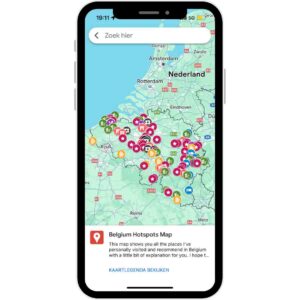Oooh Greece, the country of sunshine, magnificent islands, ancient history, and Ouzo. These are just a few of the reasons why Greece is such a perfect destination to visit! Because of its rich history and magnificent natural landscapes, the country counts many famous landmarks you should explore during your trip here.
This post is here to guide you exactly through all these famous Greek landmarks and give you a little bit more information so that you are ready to add them to your itinerary!
Let’s dive into it!
This post contains affiliate links. When you purchase through one of my links I get a small commission (at no extra cost to you). Read more in my Disclosure Policy.
19 famous Greece landmarks
Old Town of Rhodes

Recommended by Lara Hartog from The Best Travel Gifts
The old town of Rhodes was listed as a world heritage by UNESCO back in 1988, and for good reasons it is one of the most famous landmarks in Greece. It’s an exceptionally beautiful fortified city, most famous for being one of the best surviving medieval fortified cities.
The 4km long wall was built around the 14th century by the Knights of St John of Jerusalem who occupied the island at that time. They were later defeated by the Ottomans who maintained the city walls and added more monuments inside the city. This is also why you will find an interesting mix of Frankish and Ottoman architecture inside the city. And a mix between churches and mosques.
The medieval city of Rhodes is located on Rhodes island. During the summer season, you can easily reach Rhodes international airport from many European destinations. During the off-season, it’s easier to fly in from Athens. It’s also possible to reach Rhodes by ferry from Crete, though it’s a long ride (15 hours).
The best time to visit Rhodes is during the shoulder season (April until mid-June and September until October) when the temperatures are pleasant, but there are not too many tourists around.
Knossos
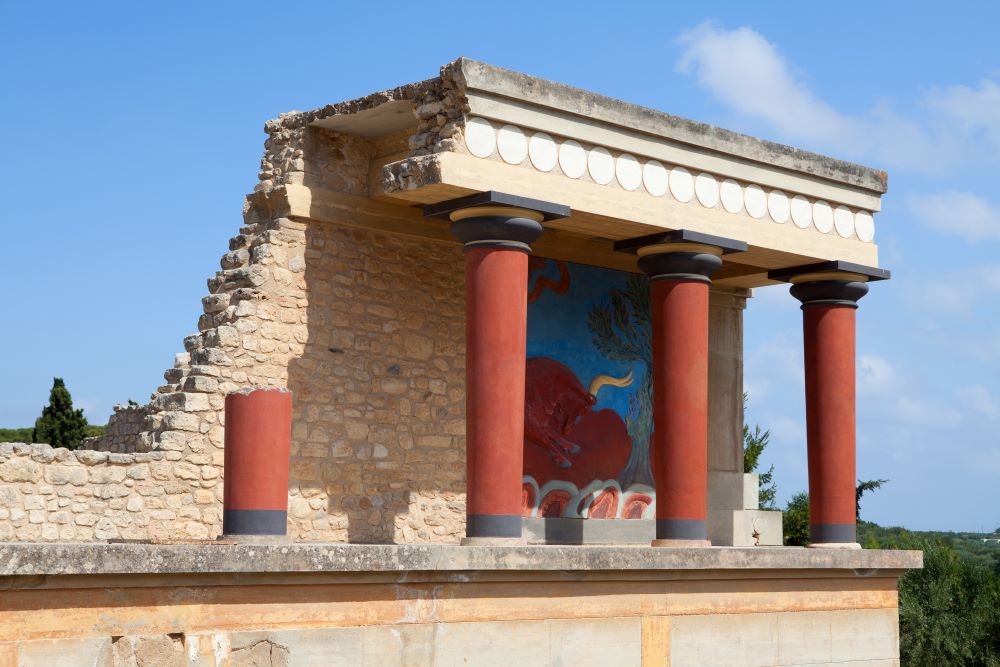
Recommended by Annabel from Smudged Postcard
The Palace of Knossos is an essential archaeological site on the southern Mediterranean island of Crete and definitely one of the most famous landmarks in Greece. Located close to the capital, Heraklion, Knossos was once the center of Minoan civilization some 4.000 years ago. At the height of its status, Knossos and the surrounding area were home to around 100,000 inhabitants.
Today, the palace is a fascinating site to explore. Although some of the excavations and renovations in the past have affected the accuracy of what the palace might once have looked like, there’s no denying the scale of the place and the wealth of those who dwelt in it.
Knossos is home to the myth of Theseus and the Minotaur – an excellent story to engage children with if you’re visiting the site as part of a Crete family holiday.
Crete can be extremely hot in the summer and Knossos can get very busy so it’s worth visiting in spring or autumn to enjoy a peaceful tour of the palace.
Temple of Apollo

Recommended by Alex from Just Go Exploring
The iconic Portara – a giant marble “doorway” – stands guard over the harbor of Naxos. It is without a doubt the most famous landmark on the island, and all that remains of the (unfinished) Temple of Apollo.
Built between 530 and 506 BC, Lygdamis (“the Tyrant of Naxos”) intended this temple to be the largest in Greece. However, Lygdamis was deposed before it was completed, and the site later fell into ruin.
Nevertheless, the Portara is still deeply intertwined with ancient Greek mythology, as it was seen as a window to the gods. Today, this colossal gateway greets all those who arrive by sea into the town of Naxos.
The best time to visit the Portara is at sunset. From the right angle, you can see the sun actually setting through the arch itself. It’s stunning.
Top tip: Stick around for half an hour or so after sunset. The other tourists will disperse, the Portara becomes illuminated with powerful floodlights, and you can have this special place entirely to yourself.
The Portara stands on a little islet (called Palatia) in the harbor of Naxos. It is reachable from the mainland via a narrow causeway and an easy 10-minute walk from the center of the town.
Naxos is connected to many other neighboring islands (including Paros, Santorini, and Mykonos), and Athens, via regular ferries. There is also a little airport on the island, with several flights per day to/from the Greek capital.
Achilleion Palace

Recommended by Corina at Another Milestone
The beauty of Corfu Island is given not only by its beautiful beaches (which alone could occupy a whole vacation) but also by the fact that you have some interesting attractions to visit in the area. One of these attractions is the Achilleion Palace, also known as the Palace of Princess Elizabeth of Austria. This is also one of the best-known landmarks in Greece.
Elizabeth (Sissi, as she has gone down in history), the Empress of Austria, had already fallen in love with Greek culture and with Corfu, her favorite holiday destination, when she decided to build a palace here. Depressed after her son’s suicide, a year later she bought the land in Gastouri on which Achilleion Palace would be built. Gastouri is located 10 km away from the island’s capital, Corfu Town.
The palace was her place of refuge and she left her mark on its decoration. Over time, the palace was a war hospital, a kindergarten, and even a casino. Now it is a museum and can be visited both inside and outside. You can reach it by car and, after paying the entrance fee, you will receive an audio guide in various languages, very detailed.
The palace itself is impressive! It is dedicated to the Greek hero Achilles and it is decorated with motifs from Greek mythology. You can walk through its rooms to admire the works of art, the objects of the royal families that lived here, and the elements of Greek culture. Its high location offers visitors beautiful views of the Ionian Sea and the green island. For hot summer afternoons, when the sun burns too hard to sit on the beach, a visit to Achilleion Palace in Corfu is a perfect choice.
Shipwreck Beach

Recommended by Paulina from UK Everyday
If you want to see one of the most beautiful beaches in the world and one of the most iconic places in Greece, look no further than Naviago Beach. This incredible famous Greek landmark is also known as Shipwreck Beach and can be found in Zakynthos.
It is famous due to its unreal turquoise water and the shipwreck that has been on the beach since 1980. Who wouldn’t want to take a picture from 200-meter tall cliffs with such a stunning view? This incredibly blue bay is one of the top attractions that you shouldn’t miss when visiting Zakynthos.
The best way to get there is to book one of the tours on the island. On your way to Naviago Beach, you will also visit a few other interesting places. Alternatively, you can rent a car and drive there. The car park is only a few minutes’ walk from the viewpoint. You will fall in love with panoramic views and visiting this landmark will be an unforgettable experience!
Lindos Acropolis

Recommended by Nadine from Le Long Weekend
One of the most famous historical attractions in Rhodes, the Lindos Acropolis dominates the hill above the town of the same name. Although the exact age is hard to determine, it is thought to have been built around the 3rd to 5th century BC.
The site is large, and there is plenty to discover within the walls of the ancient Greek fortification. Once you’ve completed the steep walk up the hill, you’ll be rewarded with one of the best views on the island! Take your time to wander around and take in the history on display. You’ll be able to explore the Doric Temple of Athena Lindia which dates back to the 3rd century BC, the Hellenistic staircase from the 2nd century BC, and the Staircase of the Propylaea dating back to the 4th century BC.
Be sure to wear sturdy footwear with a good grip as some areas can be slippery, and take some water with you, especially if you’re traveling in the warmer months. Day tours are available from Rhodes Town, and usually include time to lounge on the beaches, or take a stroll around the very pretty whitewashed town below too. Aim to go in the shoulder season of Spring or Autumn if you don’t want to battle the crowds.
Temple of Poseidon
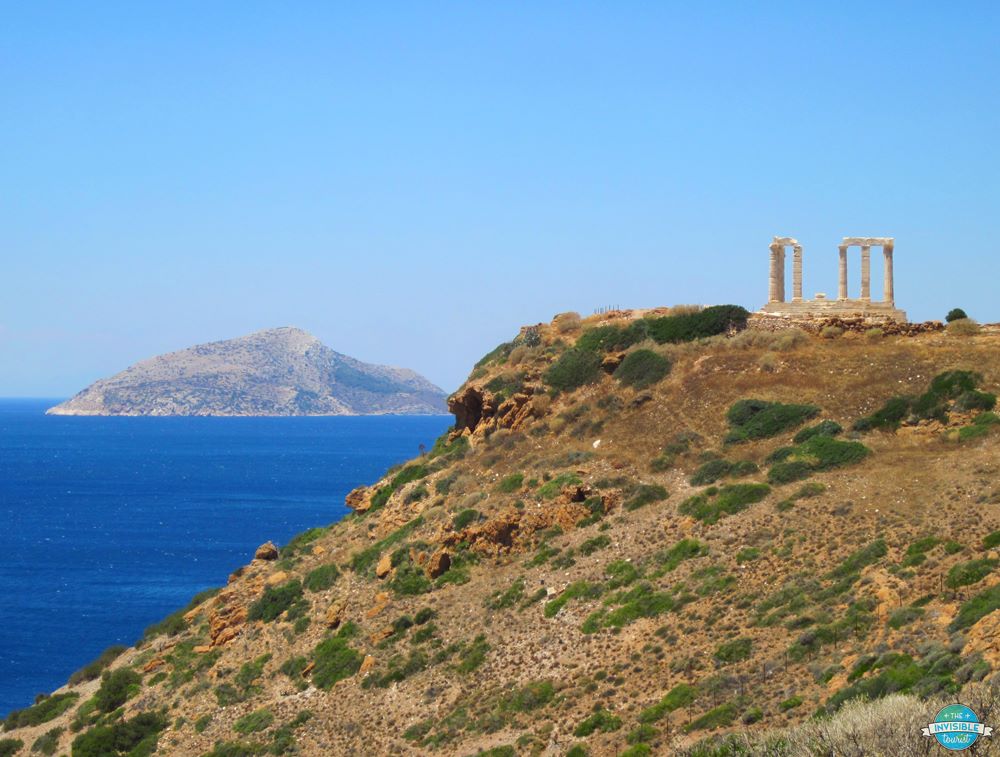
Recommended by Alyse from The Invisible Tourist
Standing proudly on a cliff’s edge overlooking swirling turquoise waters surrounding it below, the Temple of Poseidon at Cape Sounion is a breathtaking landmark of Greece.
Dating back to the 5th century BC, the temple’s remaining marble pillars are a reminder that the temple was one of the most important monuments of its time, the Golden Age of Athens.
It’s dedicated to Poseidon, one of twelve Olympians in ancient Greek mythology. As the God of the Seas, the location of his temple here on Cape Sounion is very fitting, allowing visitors to marvel at the views over the waters Poseidon once would have.
The best way to visit the temple and support local residents of Athens is to hire a private driver for the day. They’ll take the scenic route along the coast south about an hour from Athens, passing stunning rocky landscapes and crystal clear waters along the way.
If you’re able to stay in the area for the sunset, that would be a truly unforgettable experience. After all, the sunsets are one of the many reasons to visit Greece!
Cave of the Apocalypse, Patmos

Recommended by Zoe from Together in Transit
One very famous and biblical location to visit in Greece is the Cave of the Apocalypse. Located on the pretty Greek island of Patmos, this small island has a large historical story to share. You can visit by hopping on to one of the many ships that travel daily between the Greek islands.
So why is this location so special? The Cave of the Apocalypse is the known location where John the Baptise has written the Book of Revelation. This is why the island’s nickname is ‘Holy Island of Christianity’. It is known that in the year 95 AD, John stayed at least 18 months on the island of Patmos writing this book, which is the last book of the New Testament.
The cave itself is halfway up the mountain from the port of Skala to the capital city of Chora. It’s doable walking all the way up if you are pretty active, else there are local transportation and tours to join. It’s a popular destination for those who are religious, but the island itself is rather quiet and local – which can be enjoyed mostly in the spring and summer.
Once you have visited the Cave of the Apocalypse, head up to the local restaurant called Jimmy’s Balcony. They have a gorgeous view of the whole island. It’s a delicious place for a bite to eat too! From Chora you can also see the historical Greek windmills, visit the Monastery of Saint John and learn more about the importance of this little Greek island.
If you are on the island for longer than a day, rent a little car, which is cheap to do, and explore the beautiful surrounding beaches. Even during the summer months some of the beaches are only visited by locals, so it’s perfect for some relaxation and time to fully enjoy a good book, some swimming, and sunshine!
Windmills of Mykonos
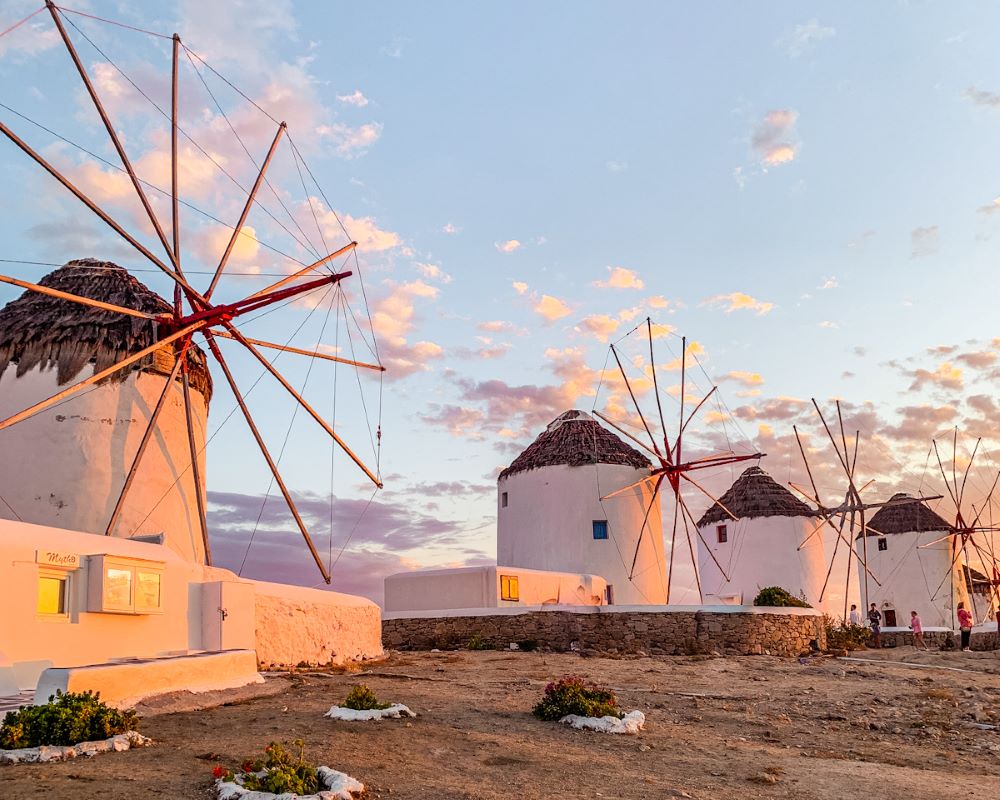
Recommended by Ophelie from Limitless Secrets
Mykonos is one of the prettiest Greek Islands in the Cyclades! In the capital, Mykonos Town, aka Chora, you will find four white windmills standing on top of a hill in front of the Sea. These windmills are some of the most iconic places in Mykonos and some of the best landmarks in Greece! They date back to the 16th century and were built by the Venetians near the famous Little Venice area. They are called Kato Mili, which means lower mills, and were initially used to mill flour.
You can see them from afar because of their higher position. They are in the center so you cannot miss them!
The best time of the day to see them is at sunset. It’s one of the most popular places to watch the sun setting in the sea in Mykonos! But if you want to have a great spot, it’s better to be there early as it gets quickly crowded at the end of the day. You can sit on the terrace of a nearby cafe to have a great view of the windmills, the sea, and the sunset!
Blue Domes of Santorini
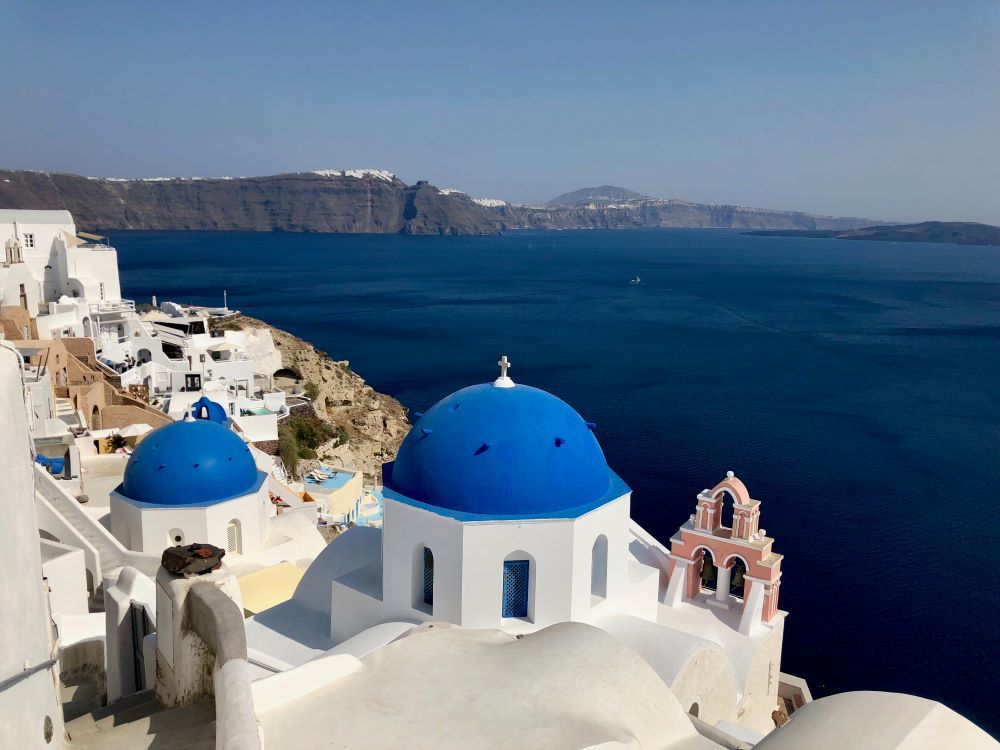
Recommended by Disha Smith from Disha Discovers
One of the most famous landmarks in Greece is the blue domes in Santorini. There are several blue-domed buildings around the island, but the most famous of them all is the three domes that are pictured on almost every postcard from Greece.
The Santorini blue domes are so famous because they offer an incredible contrast to the natural landscape. The Aegean Sea is a deep blue, and the sky is often a bright, deep blue. Against this backdrop, the white walls and blue domes of the churches stand out in stark contrast.
These blue domes are actually perched on top of two churches – Agios Spiridonas (Saint Spyridon) and Anastasios (the Church of the Resurrection). The churches themselves are beautiful, with stunning white walls and traditional Greek architecture.
The churches are located in Oia, a gorgeous village on the island of Santorini. Finding them can be a bit of a challenge since there aren’t any signs pointing the way, but these GPS coordinates will lead you close to them: 36.461245, 25.375832.
Sunset is a popular and beautiful time to visit the Santorini blue domes, but it’s also very crowded then. If you want to take a gorgeous photo without the crowds, go during sunrise.
When visiting, be mindful and respectful of the “private signs.” Don’t walk on the rooftops and don’t cross any barriers.
Lycabettus Hill

Recommended by Dymphe from Dymabroad
One of the most famous landmarks in Greece is Lycabettus Hill. This is the highest point in the city of Athens and you can go to the top of this place to get a wonderful view of the city.
What makes this hill famous is the myth associated with it. According to mythology, the goddess Athena created the hill when she dropped a mountain that was meant for the construction of the Acropolis. This story makes the hill even better to visit.
To get to the top of the hill, you can either walk or take a funicular. Once you are at the top, you have a great view of many sights of the city. For example, you’ll be able to see the Acropolis, the Temple of Olympian Zeus, and the Panathenaic Stadium from here. Also, there is a restaurant at the top where you can have a drink and food. What’s great about this place as well is the nature that you can find on the slopes of the hill.
The monasteries of Meteora
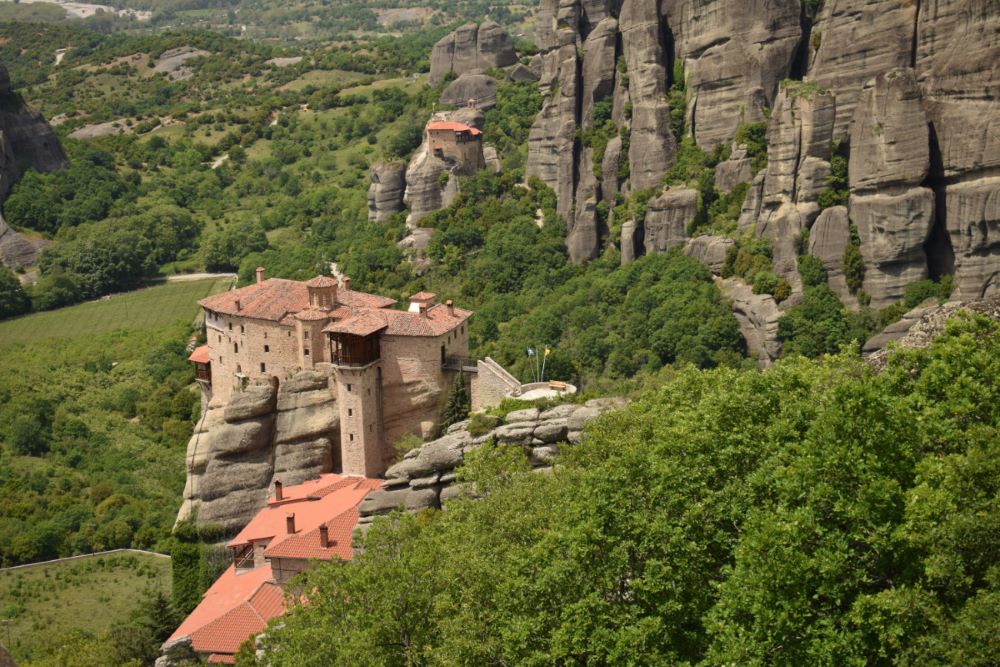
Recommended by Katja Mamacos from Travel & History
The monasteries of Meteora are a totally unique and incredibly beautiful Greek landmark. One made special by the fact that it’s both man-made and natural! These Orthodox Christian monasteries, founded in the mid-14th century, are perched atop giant pillars of rock emerging from the greenery, with rockfaces so sheer, that they’re near-impossible to scale. It’s a surreal landscape chosen for its isolation, and was in fact inhabited by hermit monks since the 10th century – but for over three centuries, these monks lived in caves in the monolithic rocks.
The Meteora Monasteries are located about two hours out of Athens and can be reached by car, train, or bus. Driving is the easiest, but you can also join a Meteora tour! It’s best to visit in spring, as the weather is perfect for hiking to the monasteries, and the landscape is lush.
The whole area was once dotted with monasteries, but today you’ll find six active and open holy places. If you can’t visit them all, I’d recommend the two biggest, The Monastery of Great Meteoron and The Monastery of Varlaam. Both are phenomenal, and you can see how the monks used to live, and still live today.
Temple of Olympian Zeus

Recommended by Steve Rohan from thetripgoeson
The Temple of Olympian Zeus is an archaeological site in central Athens that is home to an impressive array of huge pillars dating back thousands of years (6th Century BC). Although only 15 of the original 104 pillars are still intact, some are still standing upright.
Given that the site has been plundered throughout the ages and suffered devastating earthquakes, it’s incredible to witness some of these beautiful Corinthian pillars standing tall with a backdrop of the Acropolis behind.
One of the most special times to visit the site is at sunrise or sunset during the summer months when the columns are bathed in a glorious red sunlight.
Be sure to check out local guides such as Time Out as the site hosts different concerts and events throughout the year.
The temple is located on Syggrou Avenue and is easily reachable from anywhere in the city. The nearest metro stop is Acropolis (line 2) which is a ten-minute walk. The admission price is €6 ($6.60).
Delphi
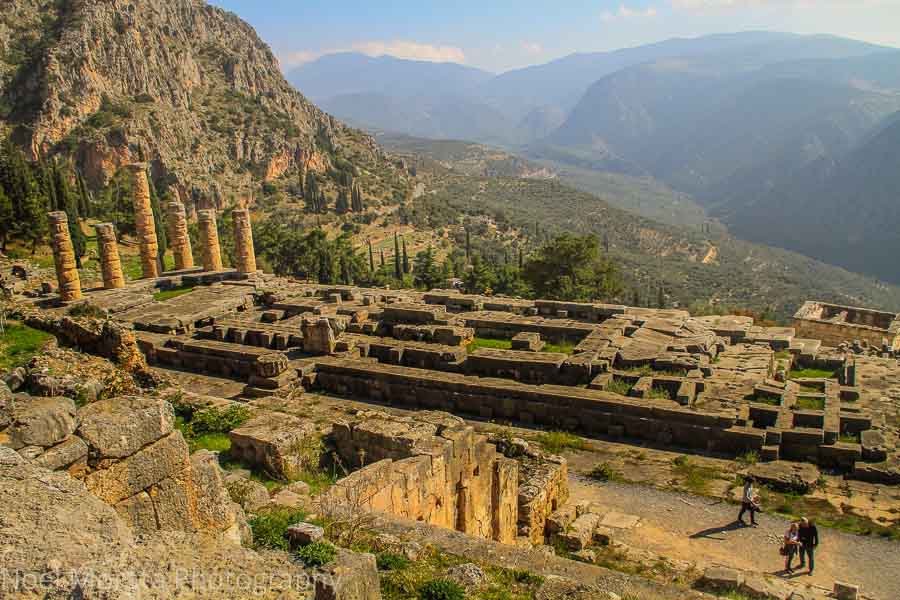
Recommended by Noel Morata from This Hawaii Life
One of the most famous and must-visit landmarks in all of Greece is Delphi, one of the most impressive archaeological sites in the country. The site is well known in ancient times for pilgrims that would come to Delphi to receive the prophecies of the ancient god of Greece, Apollo. These prophecies were delivered to the pilgrims from the high priestess, Pythia. Delphi at that time was considered the center of the earth, a religious sanctuary, and also a strategic military and political base in the region.
Visiting the site and ruins is fascinating and the guides here take you to the most significant monuments along with the gorgeous vistas and viewpoints around the site. Spend some time in the beautiful museum with artifacts and collections that really add to the experience and visit.
Delphi is an easy day trip that you can do from Athens and there are a lot of local tour companies that offer this type of experience. You can opt to do this DIY on your own and even do a few days exploring the region along with this historic site and cool places to visit along the way.
Mycenae
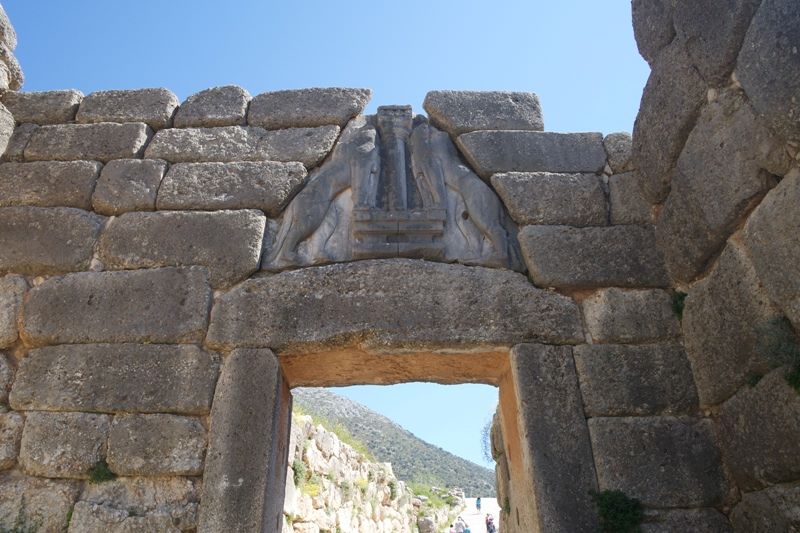
Recommended by Chrysoula from Greece Travel Ideas
The UNESCO Heritage Site of Mycenae is one of the most important archaeological sites in Greece. Mycenae is located just 120 km away from Athens, in the Peloponnese region, making it a great choice for a day trip. If you don’t rent a car the easiest way to get there is by a guided tour.
During the second millennium BC, Mycenae was one of the most powerful cities of the ancient world, and according to mythology was the kingdom of Agamemnon, who led the expedition against Troy in the Trojan war.
Today, visitors can admire the Treasure of Atreus, one of the most impressive Mycenaean tombs (tholos), the Lion Gate of Mycenae which was the entrance to the Acropolis, the two Burial Enclosures that were part of an extensive prehistoric cemetery, the Vaulted Tomb of Clytemnestra, the Royal Palace, the North Gate, the Temple, and the Underground Tank. A full ticket costs €12 and the reduced ticket €6.
Olympia

Recommended by Ania James from The Travelling Twins
When you are exploring Greece with kids, you shouldn’t miss one of the ancient Landmarks, which is the Olympia site located on the Peloponnese.
The Olympia temple is one of the most famous landmarks in Greece. Dedicated to Zeus, this ancient site dates back to the 5th century BC. Visitors can explore the ruins and marvel at the beauty of this ancient landmark.
Olympia was considered a sacred place by the ancient Greeks and was home to the ancient Olympic Games. The Olympics were held in Olympia as early as 776 BC, and they continued every four years until 393 AD when the Olympics stopped during the Christian era.
Today, visitors can explore the Olympic site of Olympia and learn about its rich history, as well as have a run in the place where 2000 years ago Greek competed. Next to the archaeological site is a great Archaeological Museum of Olympia, where you can learn about the site’s history and the Olympics.
Little Venice
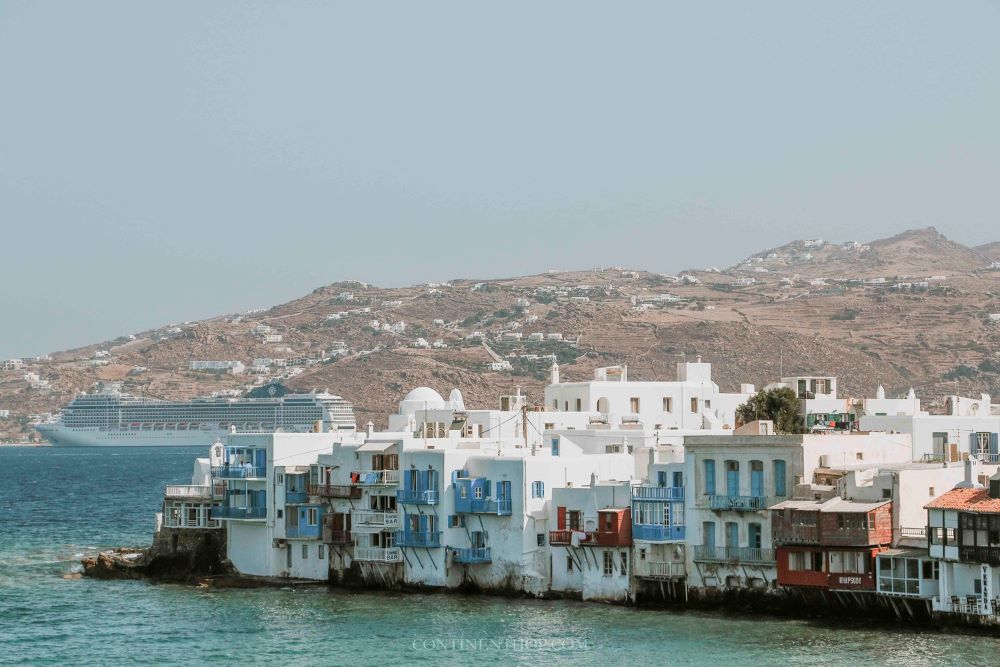
Recommended by Lavina Dsouza from Continent Hop
One of the most photographed places not only in Mykonos but in all of Greece is Little Venice. Rightfully so as not only is the location quite romantic, it is also popular because of its location by the sea with numerous popular restaurants by its side. These restaurants have little terraces where people can have a drink while they enjoy watching some of the best sunsets on the island and the Mediterranean!
There are gorgeous white and colored houses in the alleys surrounding Little Venice, where taking an evening stroll should be at the top of your bucket list when visiting Mykonos.
Alefkandra beach is located here and many artists live in the vicinity. It is impossible to miss Little Venice as a short walk (about 5 minutes) by the Fabrika bus station and if you’re in the old part of the town, chances are you’ll come across it no matter which direction you pick!
While grabbing a drink or something to eat here is recommended especially during sunset, you don’t necessarily have to pay a visit to the bars to do so as there’s ample space by the promenade where you can sit and enjoy the view. Visitors can also find many clubs in the area if they fancy a night put partying nearby!
Delos
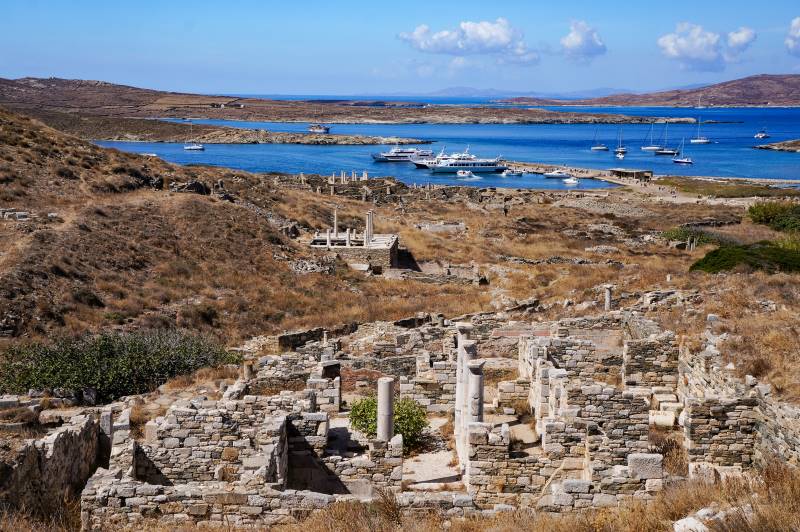
Recommended by Roxanne from Faraway Worlds
If you’re considering island-hopping through Greece, be sure to include a day trip to the archaeological site of Delos in your itinerary. Delos was first settled over 5,000 years ago and is the mythological birthplace of the ancient Greek gods Apollo and Artemis.
Since then, Delos has served as a sanctuary of Apollo, a commercial port, and a political hub of ancient Greece. Now an uninhabited island, Delos is home to a sprawling archaeological site that’s easily accessible from Mykonos or Naxos,
Excavation began in Delos in the 1800s and is still ongoing, with much of the ancient city yet to be restored. Spend your visit walking through the ancient roads and spying glimpses of beautiful mosaics through crumbling doorways. If you have time, climb to the top of Mount Cynthus for panoramic views of the ruins with the blue Mediterranean in the distance.
You can get to Delos on an organized day trip from Naxos or Mykonos. There are also ferries that leave from Mykonos twice daily, in the morning and early afternoon.
Corinth Canal

One of the most famous landmarks in Greece without the usual historic ruins is the canal of Corinth, which is a man-made canal separating the Peloponnese from the Greek mainland and connecting the Ionian Sea with the Aegean Sea.
Today, it is quite impressive to see this long but small canal that anyone wishing to reach the Peloponnese over land should cross. Especially knowing it has been dug a few centuries ago. However, since the canal is so small it barely has any commercial function and is thus rather just a touristic attraction.
So if you would by accident cross this canal on your Greece trip, definitely make a stop and admire the steep limestone cliffs that stretch more than 6 km!
Conclusion
I hope this blog post forms an exhaustive overview of all the famous landmarks in Greece that you should know about and visit. If you have any other suggestions that I missed, feel free to add them in the comments!








